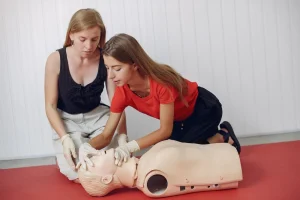


Cardiopulmonary Resuscitation, or CPR, is widely known as a lifesaving procedure conducted in an emergency on a person experiencing cardiac arrest. It is one of the most basic medical methods everyone should learn to save a life in times of crisis. This technique has been around for centuries to save lives in an emergency.
Cardiopulmonary Resuscitation uses chest compressions to maintain blood flow and oxygen to the brain during a cardiac arrest. Even though the survival rates and outcomes are not great for those suffering from cardiac arrest, immediate CPR, which includes early defibrillation, can increase the chances of survival considerably.
Here is a complete guide to CPR, including its origins, evolution, training, and importance, to help you learn more.
Cardiopulmonary Resuscitation (CPR) has been saving lives worldwide for centuries. With updated guidelines, CPR has improved significantly, increasing the probability of saving lives.
CPR dates back to 1740, when mouth-to-mouth resuscitation was used to save the lives of drowning victims in Paris. Dr. Friedrich Maass performed the first official chest compression in humans in 1891, followed by Dr. George Crile, who conducted the first successful external compression in human Resuscitation in 1903.
In the 1960s, CPR procedures evolved significantly. After years of other discoveries in oxygenation and chest compressions, the American Heart Association (AHA) introduced the CPR technique in 1960. However, the first mass citizen training in CPR took place in 1972 in Seattle, Washington.
Since then, CPR has gained massive popularity, with online courses launched in the 2000s. In 2008, ‘compression-only’ CPR was also introduced to motivate bystanders to get involved if a person experiences a cardiac arrest.
In 2010, the American Heart Association (AHA) rearranged the steps in which CPR was initially conducted. Previously, CPR followed the A-B-C method, which entailed three main stages: Airway and Breathing first and then Chest Compressions.
However, the process was changed to support the C-A-B method. This method used the same three steps but in a different pattern: Chest Compressions, Airway, and Breathing.
The original CPR method, emphasizing the A-B-C technique, lasted for almost 40 years. It instructed the responders to open the patient’s airway by tilting their head backward, pinching their nose and breathing into their mouth, and following through with chest compressions. When the method eventually changed to C-A-B, the responders were asked to immediately give chest compressions to a cardiac arrest patient followed by breathing into their airway.
After decades, the sudden change of the procedure from A-B-C to C-A-B made people curious about why the change happened in the first place. In actuality, conducting CPR in the A-B-C sequence delayed chest compressions as the responder first focused on normalizing breathing.
However, the delayed compressions would prevent oxygen-rich blood from circulating through the body, making it difficult to bring the patient back to normal. By changing the method to C-A-B, chest compressions are started sooner, and the ventilation of the patient is only delayed until the first cycle—comprising 30 chest compressions—is completed.
Moreover, the previous guidelines suggested by the AHA entailed looking at and listening to a patient’s breathing before starting CPR; however, it is now recommended to initiate the compressions immediately.
This change in the procedure occurred because, during the initial few minutes of a cardiac arrest, the patients still have oxygen within their lungs and bloodstream. By commencing the CPR process with chest compressions, the blood is pumped to the patient’s heart and brain sooner, increasing the chances of survival.
An important point to remember is that this transformation of the CPR process applies to infants, children, and adults but excludes newborns.
CPR training is typically provided individually or in conjunction with First Aid training. Cardiopulmonary Resuscitation comprises chest compressions and administered breaths.
If you are opting for CPR training, you can expect to learn the following from your trainer:
Your CPR trainer will also discuss the Samaritan laws and your responsibility as a good citizen to help someone in distress. Moreover, they will also enlighten you about your liability concerns.
Apart from the basics of CPR, you will also learn how to gain control of an unfortunate incident to provide the best possible care to a patient. Furthermore, this training teaches you how to delegate and assign tasks while remaining calm and composed.
Cardiopulmonary Resuscitation (CPR) training also includes a few necessary steps that use specific techniques to save a life.
Once your instructor covers the topics above, the fun part begins! Your instructor will help you with hands-on training. You will be practicing techniques on dummies and role-playing with fellow learners.
The trainer might intermittently provide you with hands-on training throughout the day to keep the lecture more engaging or reserve it for the end.
In the role-playing portion, you and your fellow learners will act out different medical emergencies, teaching you to assess and analyze a situation. During this time, it’s pivotal for you to ask as many questions as you can to comprehend your role in the emergency. Your instructor will make you practice CPR (Cardiopulmonary Resuscitation) and AED (Automated External Defibrillator) on dummies.
Your instructor will continuously ask questions to test your learning from the activities. Moreover, they will analyze your techniques to gauge your basic understanding and guide you effectively. At any point, if you are doing something wrong, your instructor will help you thoroughly.
By opting for CPR training, you should be prepared to practice the following:
One-person CPR is a situation in which you’re the first responder on a scene where someone is experiencing a heart attack, stroke, or cardiac arrest. It will teach you how to comfort a patient before starting the mandatory CPR cycle that includes chest compressions followed by rescue breaths if necessary.
Another significant portion of the training includes CPR training with mandatory rescue breaths. So, this entails training for chest compressions followed by rescue breaths.
Hands-only CPR is also known as compression-only CPR or compression-only Resuscitation. It is termed compression-only Resuscitation because it only involves compressions, not rescue breaths.
You are also trained to work with another person to ensure the well-being of a victim. While being part of a two-person rescue team might not be comfortable, by adapting to it accordingly, you can receive some extra help to get a grip on the job. In this training, one person delivers chest compressions. At the same time, the second rescuer keeps the victim’s head up to keep their airway open.
Lastly, most CPR training teaches you to use an Automated External Defibrillator or AED.
Whether or not you are a medical professional, receiving CPR training is crucial. Cardiac arrests mostly tend to occur at home or in public places. In such cases, the first responder handles the situation before medical help arrives. The person closest to the patient at that moment can be anyone, from a family member to a friend, an office colleague, or even a random bystander without any expertise in the medical field.
By providing help instantly to the unresponsive patient in the form of CPR, the patient’s chances of survival can increase considerably. The initial time when a person experiences cardiac arrest is exceptionally crucial. Once a person’s heart stops beating, the blood flow naturally ends, causing them to lose consciousness in 15 seconds. If another 30 to 60 seconds pass by without the person receiving any help, they will stop breathing altogether, causing irreversible damage to their brain and plausible death.
CPR training is a mandatory life-saving technique that helps everyone around you. By acquainting yourself with the CPR method through practice and training, you can help save a life!
Since CPR training is so necessary, you should opt for one. We provide exceptional CPR and AED training to laypeople, ensuring that if you’re ever in a situation like this, you will be able to save a life. Visit our website and register now!
Since CPR training is so necessary, you should consider being trained. Providing exceptional CPR and AED training to laypeople and medical professionals, we ensure you can save a life if you’re ever in a situation like this.
ABC Health and Safety Training has led emergency training classes in Vacaville, California, for over 25 years. To learn to save lives, check out our available courses.